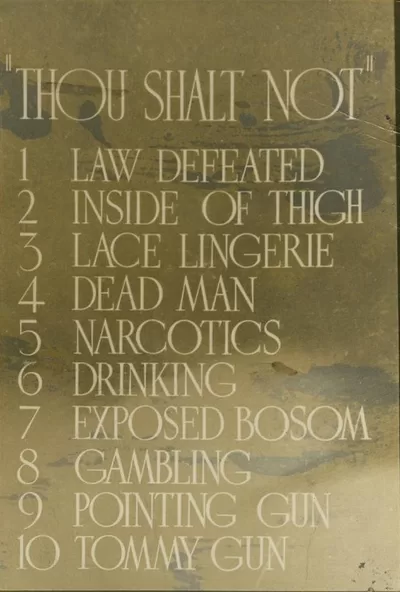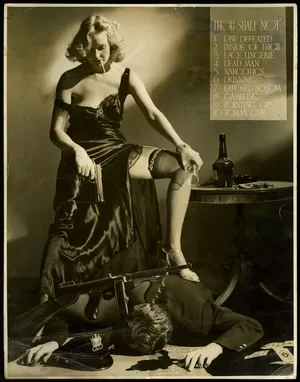Schafer’s 1940 photograph, “Thou Shalt Not,” serves as a satirical commentary on the restrictive guidelines of the Hays Code. In this parody, Schafer ingeniously includes ten forbidden elements outlined by the code, effectively challenging its censorship rules.
Depicting a sex worker, a deceased policeman, and liquor, the photograph incorporates each of the banned objects and concepts listed by the Hays Code. Through this provocative imagery, Schafer boldly critiques the code’s limitations on artistic expression and social commentary.
With its clever and subversive portrayal of taboo subjects, “Thou Shalt Not” stands as a testament to Schafer’s defiance against censorship and his commitment to pushing the boundaries of creative freedom in the face of restrictive regulations.
In 1940, Whitey Schafer (1902/3–1951) captured the iconic photograph “Thou Shalt Not,” intending to defy the restrictive regulations of the Hays Code.

This code, established in response to the perceived immorality of 1920s and ’30s films, sought to impose strict guidelines on the content of motion pictures. Schafer’s photograph was a bold protest against these constraints, aiming to challenge all ten of the Motion Picture Production Codes in a single image.
Before the enforcement of the Hays Code in 1934, films of the pre-Code era were known for their daring and often risqué themes. However, as pressure from religious and conservative groups mounted, the industry bowed to censorship, leading to a stark shift in content and tone.
Schafer’s photograph, a striking visual critique of the Hays Code, gained widespread recognition for its audacious defiance. Each of the ten commandments of the code was symbolically broken within the frame, showcasing the artist’s bold rejection of the restrictive regulations. This powerful image became emblematic of the profound impact of the production code on the film industry.
Reverberating through countless film history books, “Thou Shalt Not” remains a poignant reminder of the struggles faced by filmmakers against censorship and the enduring legacy of the Hays Code on American cinema.
One picture sold through Heritage Auctions for over $500 with a description: “Production Code Still (Unknown, 1930s). “Thou Shalt Not” Still (11″ X 14″). Miscellaneous. Famous vintage photo published in Life Magazine in the late 1930s showing all the “don’ts” of the Hays Production Code which came into effect in 1934. An unrestored photo that displays signs of use. May include light edge or fold wear. Fine/Very Fine.”
The Hays Code
The Hays Code, also known as the Motion Picture Production Code, was a set of industry guidelines for the self-censorship of content in American films. It was named after Will H. Hays, who was the president of the Motion Picture Producers and Distributors of America (MPPDA) from 1922 to 1945. The Hays Code was implemented in 1930 but wasn’t strictly enforced until 1934. It remained in effect until the mid-1960s, when it was gradually replaced by the modern film rating system.
The Hays Code was developed in response to public and political pressure to address what was seen as immoral content in films, including themes of sexuality, violence, and profanity. Its purpose was to maintain a certain standard of morality and decency in American cinema, reflecting the social and cultural values of the time.
“The Don’ts and Be Carefuls” (1927)


The Motion Picture Production Code and its accompanying guidelines, became commonly known as the Hays Code, or the “Don’ts and Be Carefuls”. This is the Motion Picture Production Code:
Resolved, That those things which are included in the following list shall not appear in pictures produced by the members of this Association, irrespective of the manner in which they are treated:
1. Pointed profanity-by either title or lip-this includes the words “God,” “Lord,” “Jesus,” “Christ” (unless they be used reverently in connection with proper religious ceremonies), “hell,” ” damn,” “Gawd,” and every other profane and vulgar expression however it may be spelled;
2. Any licentious or suggestive nudity-in fact or in silhouette; and any lecherous or licentious notice thereof by other characters in the picture;
3. The illegal traffic in drugs;
4. Any inference of sex perversion;
5. White slavery;
6. Miscegenation (sex relationships between the white and black races);
7. Sex hygiene and venereal diseases;
8. Scenes of actual childbirth-in fact or in silhouette;
9. Children’s sex organs;
10. Ridicule of the clergy;
11. Willful offense to any nation, race or creed;
And be it further resolved, That special care be exercised in the manner in which the following subjects are treated, to the end that vulgarity and suggestiveness may be eliminated and that good taste may be emphasized:
1. The use of the flag;
2. International relations (avoiding picturizing in an unfavorable light another country’s religion, history, institutions, prominent people, and citizenry);
3. Arson;
4. The use of firearms;
5. Theft, robbery, safe-cracking, and dynamiting of trains, mines, buildings, etc. (having in mind the effect which a too-detailed description of these may have upon the moron);
6. Brutality and possible gruesomeness;
7. Technique of committing murder by whatever method;
8. Methods of smuggling;
9. Third-degree methods;
10. Actual hangings or electrocutions as legal punishment for crime;
11. Sympathy for criminals;
12. Attitude toward public characters and institutions;
13. Sedition;
14. Apparent cruelty to children and animals;
15. Branding of people or animals;
16. The sale of women, or of a woman selling her virtue;
17. Rape or attempted rape;
18. First-night scenes;
19. Man and woman in bed together;
20. Deliberate seduction of girls;
21. The institution of marriage;
22. Surgical operations;
23. The use of drugs;
24. Titles or scenes having to do with law enforcement or law-enforcing officers;
25. Excessive or lustful kissing, particularly when one character or the other is a “heavy.”
“Frankly, my dear, I don’t give a damn”
During the enforcement of the Hays Code, many famous movies faced censorship or had to adhere to strict guidelines regarding content deemed inappropriate. One notable example is “Gone with the Wind” (1939), directed by Victor Fleming. In the film, Rhett Butler, portrayed by Clark Gable, famously utters the line, “Frankly, my dear, I don’t give a damn,” which became one of the most iconic quotes in cinematic history.
This line caused significant controversy due to the use of the word “damn,” which was considered profanity under the Hays Code. However, producer David O. Selznick fought to keep the line in the film, arguing that it was crucial to the character and the scene’s emotional impact. Ultimately, the line was allowed to remain, making “Gone with the Wind” one of the first major Hollywood productions to challenge the strict censorship of the Hays Code.
Despite its success and enduring popularity, “Gone with the Wind” faced other censorship issues related to its portrayal of race and slavery, which were sensitive subjects even during the Hays Code era. The film’s romanticized depiction of the antebellum South and its portrayal of African American characters were criticized for perpetuating racial stereotypes.
“Gone with the Wind” stands as a landmark film in cinematic history, not only for its epic scope and storytelling but also for its defiance of censorship and its impact on the evolution of filmmaking in Hollywood.
The end of the Hays Code
The Hays Code had a significant impact on the content of American films during its enforcement period. Filmmakers had to navigate strict censorship rules, often resorting to creative methods to convey controversial themes or messages indirectly. However, the code also led to the creation of memorable films that employed subtlety and innuendo to address social issues within the constraints of the censorship guidelines.
As social attitudes began to change in the 1960s and 1970s, the Hays Code became increasingly outdated and restrictive. It was eventually replaced by the modern film rating system, which allows for a wider range of content while providing guidance to viewers about the suitability of films for different age groups. Despite its limitations, the Hays Code remains an important chapter in the history of American cinema, reflecting the ongoing tension between artistic expression and social conformity.
Whitey Schafer
Adolph L. “Whitey” Schafer (1903 – August 31, 1951) was an American photographer celebrated for his pin-up and glamour photography. Hailing from Salt Lake City, Utah, Schafer spent his formative years in California, where his passion for photography blossomed. His career in the film industry commenced in 1921, capturing still images of Hollywood stars for esteemed studios such as Columbia and Paramount.
Tragically, Schafer’s life was cut short by a fatal explosion aboard a yacht in 1951. Despite his untimely demise, his artistic legacy endures, continuing to inspire generations of photographers and admirers alike.
Schafer’s talent behind the lens earned him widespread recognition and contributed to the visual allure of countless films. His distinctive style and keen eye for detail left an indelible mark on the world of photography, solidifying his reputation as a master of his craft.
Related stories
Stanley Kubrick career as a still photographer
Photographer Paul Dubotzki in Australia’s WWI Internment Camps
Andre Kertesz, a pioneer of street & fine art photography
Sebastião Salgado lens on Humanity’s Struggle and Resilience
Brecht’s Man Equals Man by Theatre of the Deaf
Heinrich Hoffman photographs Adolf Hitler public speaking
Dorothea Lange’s Pioneering Approach to Portraiture
State Library of New South Wales 20th Century photography
The first photograph taken in Australia was by Captain Lucas
Australia’s first professional photographer George B Goodman
The oldest surviving Daguerreotype in Australia, 1845







